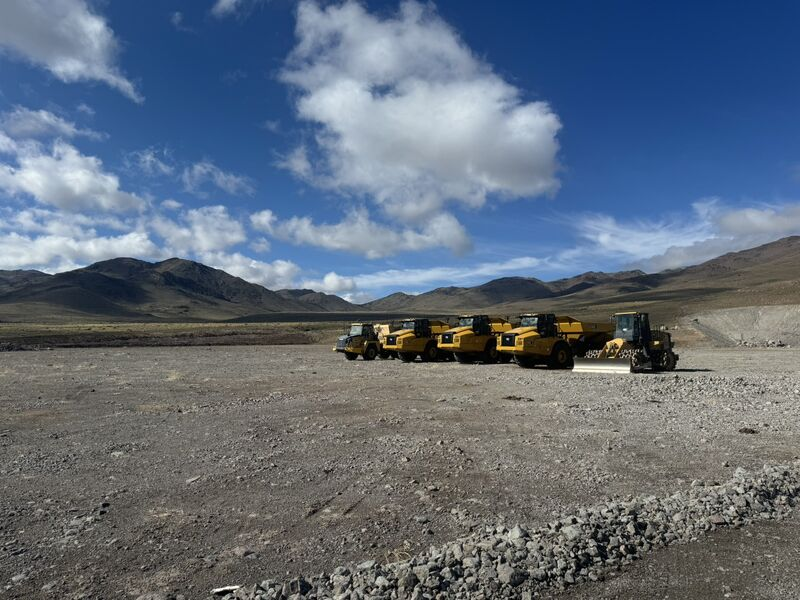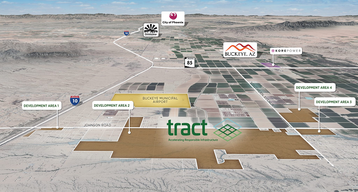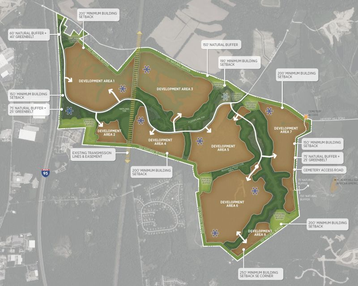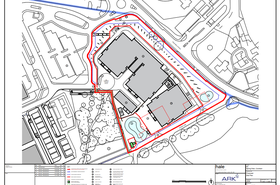Grant van Rooyen, best known as the founder and former CEO of Cologix, is back with a new venture, called Tract.
Rather than building data centers for hyperscalers, the new company aims to build ‘master-planned data center parks,’ providing all the required infrastructure and permits that allow wholesalers and hyperscalers to build their own data centers on shovel-ready land.
While Tract isn’t the first wholesaler-to-the-wholesalers the data center industry has seen, the company’s ambition is noteworthy: In less than 12 months, the company has officially announced plans for almost 5GW of capacity across three locations – with more in the pipeline.
New venture, new masterplan
Van Rooyen began his career at Level 3 Communications, leaving in 2009 after an 11-year stint. He then founded US data center operator Cologix alongside investment firm Columbia Capital (ColCap), leading the company as chief executive officer for eight years.
He left Cologix in 2018, a year after Stonepeak acquired a majority stake in the firm, with Bill Fathers taking the helm. That year Stonepeak also acquired Communications and Realty Investments, a van Rooyen-led company that owned data centers in Columbus, Jacksonville, and New Jersey.
Though he hasn’t been in the spotlight at the helm of an operator since, van Rooyen has been busy in the interim.
“We have a long history of successfully executing in the space, and we generally tend to do it behind the curtain,” van Rooyen tells DCD. “After I left Cologix, I certainly didn't sit on the beach.”
In 2022, the van Rooyen Group, a family investment group led by Grant, acquired 49 percent of Israeli data center operator MedOne alongside US private investment firm Berkshire Partners. That same year, Digital Realty acquired a majority stake in South African operator Teraco from a consortium of investors, including Berkshire Partners, Permira, van Rooyen Group, and Columbia Capital. All three still have an interest in the firm.
News of Tract first surfaced in 2022 after flyers were sent to investors, with the newly formed company claiming to have identified 40,000 acres worth of potential sites and was seeking $1 billion to fund its lofty ambitions.
At the time, ColCap and the van Rooyens were said to be involved, with the latter investing $50m to get Tract going. Berkshire Partners is also a named investor.
Where Cologix, MedOne, and Teraco develop data centers, this latest venture is targeting massive parks that hyperscalers and their wholesalers can develop their own campuses on.
The Colorado-based company describes itself as a company that acquires, zones, entitles, and develops master-planned data center parks to provide to data center end users - whether cloud or wholesaler.
“Our primary objective is to deliver speed and certainty for our customers,” says van Rooyen. “Regardless of who's doing the vertical development, what they value the most is the ability to move with speed and certainty; predictable developments where the roadblocks have all been removed.”
A new data center reality
“It became fairly obvious around three years ago that the feedstock for all of this infrastructure is getting very scarce,” van Rooyen says. “What was 20MW is now 100MW; 100MW is 250MW; 250MW is a gigawatt, and we'll continue to see that ratchet up.
“That has profound implications for where you can locate this infrastructure and the size of the feedstock and magnitude that's required to feed it. So we came to the conclusion that this was an area we wanted to explore.”
He says that customers have behaved over the years as though this is a spot market, that when you require capacity somewhere, you can easily procure it. Now, he warns, those days are gone.
“We're focused on making sure we own tomorrow's building block. That means we take a very long-term view; in many cases 10-plus years.”
Tract won’t be engaging in building its own data centers, and will instead focus on ‘horizontal development.’ That will include acquiring land, taking it through rezoning and entitlements so that data centers are allowed by right on the land, and having energy available.
“We push dirt, we build roads, we grade pads, we deliver wet infrastructure, both water, and sewer, and will master-plan the site to the point where somebody can come in, in whole or in part, and procure these positions and begin building as quickly as they can submit a building permit and pull that permit,” van Rooyen says.
Reno, Eagle Mountain, Richmond
The company made a splash with its tract on more than 20,000 acres across the United States, which are in various stages of rezoning, design, or horizontal construction. Van Rooyen tells DCD the company has around 50 people working to take its projects through the permitting and development process.
The company made a splash with its first official announcement; a 2,200-acre data center park outside Reno, Nevada.
It acquired the land inside the Tahoe-Reno Industrial Center (TRIC) in Storey County and has commitments from NV Energy to deliver more than 2GW of power, beginning in 2026.
Tract reportedly acquired the land from Blockchain LLC. Blockchain had planned a 5,000-acre blockchain-powered smart city/innovation zone that would house 35,000 people. After acquiring the land in 2018, the plans were dropped around 2021.
Ground was broken on the first 810MW phase of the Reno development – now known as the Peru Shelf Technology Park – in May 2024. The company has also acquired another 510 acres within the TRIC, currently in the planning stages.
It has also alluded to another 1,500-acre, 1.2GW campus nearby known as the South Valley Technology Park. Since this article was originally published in DCD>Magazine, Tract has taken its total landholdings in Reno to more than 11,000 acres across three sites.
Then came Eagle Mountain, Utah. The company has acquired just under 670 acres south of Salt Lake City and is working with Rocky Mountain Power to deliver more than 400MW by 2028.
That campus is identified as ‘Project Tripletail’ on the Economic Development Corporation of Utah’s website, which suggests a potential investment of up to $7bn.
Finally, May 2024 saw the company officially announce plans for a 2.4GW data center park outside Richmond, Virginia.
The Hanover Technology Park will span 1,200 acres of land, with bridging power expected on the site by 2026.
Planning documents suggest up to 46 buildings may be developed on the site, located on the south line of Hickory Hill Road (State Route 646) at the intersection with Old Ridge Road (State Route 738). The company reportedly paid $33m for the undeveloped land.
There are more announcements to come. Van Rooyen says Tract is operating in ten markets – with multiple campuses in many locations.
“We haven't announced many of those markets and we won't until we've facilitated the certainty that we require before we'll make that public. We will not announce the project until it's fully entitled, zoned, and owned,” he says.
He notes these are a combination of existing hubs – Phoenix, Arizona, and the wider Virginia market – as well as more up-and-coming markets such as Reno. While van Rooyen says brownfield sites have merit, the “lion’s share” of Tract’s current developments are greenfield sites.
For now, van Rooyen says Tract’s first investment vehicle is focused on the US. On expanding abroad in future, he reiterates his experiences abroad over the years and adds that he “knows the strategy can travel.”
Stumbles (and rebirth) in Phoenix
Larger and larger data center campuses are garnering more attention from the public than ever before, much of it negative. It’s becoming increasingly common to see pushback on large-scale projects from residents and local politicians, especially in markets with sizeable data center footprints.
With Tract making such sizable proposals, van Rooyen is clear that outreach and engagement are cornerstones of the company’s ambition to deliver long-term certainty around its planned campuses.
“These developments need to work for the communities in which they exist. And we take this seriously at Tract,” he says. “I think for too long, the industry has assumed that the data centers are welcome everywhere and belong everywhere.
“That may have been okay when we were at 5, 10, 20MW scale. But gigawatt campuses can't just live anywhere and everywhere. We don't just go and buy what's for sale. These locations are unique in their magnitude and they need to be located in places where ultimately you can work productively with cities and counties, and the communities. That doesn't mean everywhere.
“Over the years, our industry hasn't done itself favors by operating behind the curtain,” he adds. “We're very clear from the start, who we are, what our intended uses are, and who our ultimate customers are likely to be. That transparency is not just overdue, it's fundamentally necessary.”
Tract’s pitch for long-term planning means cities and counties can avoid a lot of ‘ad hoc’ development; what van Rooyen describes as ‘20MW here, 50MW there,’ in a disordered manner that might upset local residents.
“As these areas evolve and clustering intensifies, many participants in these communities look at them and say, ‘How did that happen?’ The solution, we believe, is master planning; let's sit down productively with these communities and engage with them on where they want data centers to develop at scale, and answer that over a 10-plus year period.”
While zoning and entitlements for the site were approved unanimously by both the Hanover County Planning Commission and Board of Supervisors, the Virginia campus only finally gained approval after several months of delays by county officials.
“Our Virginia project has been two years in the making. And that's not two years of checking in once a quarter. That's pick and shovel work every day for two years, from a group of people, not one or two people,” says van Rooyen.
Elsewhere, however, Tract hasn’t been so lucky. In April, the company pulled an application to develop a large campus in the Buckeye area of Phoenix.
The company had been plotting a $14bn master-planned data center complex across 1,000 acres in the Buckeye area of Maricopa County, to the southwest of Phoenix.
Known as Project Range, the development was due to span nearly 30 buildings totaling 5.6 million square feet on land along Yuma Road between Jackrabbit Trail and Perryville Road. Buildings were set to range from 149,000 square feet to 260,000 square feet each.
Plans for the project were first submitted in late 2023, and work on the project was set to start in 2025, continuing over the next 15 to 18 years.
Tract withdrew the application from Maricopa County’s planning and development queue after opposition from local residents and other stakeholders.
The project received pushback from both Goodyear and Buckeye City staff because of its "incompatibility" with the designated land uses for the site along with concerns around building heights and noise. The site is currently designated for residential uses and is surrounded by neighborhoods.
Tract had already submitted revised applications reducing the proposed heights of the data centers and increasing the setbacks, before withdrawing the application altogether.
“While we worked productively with the city of Buckeye and Maricopa County, ultimately we came to the conclusion with our partners in the community and in the city that it was not the right place to locate a data center campus of this magnitude,” van Rooyen says of the issue.
While that project is done, the company isn’t giving up on Phoenix.
“We withdrew that application, but we certainly haven't withdrawn our appetite for the market and we continue to work very productively with the city of Buckeye. Watch this space.
“We have other projects in that city, and we are advancing those very productively. We very rarely go into a market with only one solution. In some of these markets, we will ultimately have multiple solutions. Reno is a perfect example.”
When DCD suggests it’s rare for a developer to withdraw an application completely, van Rooyen replies that forcing an outcome is never productive.
“We will always be tenacious, but we're reasonable,” he suggests. “It's a massive investment, and it belongs in the right location. We're prepared to be patient to find those locations in partnership with our city and county partners, and the people that live in those communities.”
True to his word, since DCD spoke to van Rooyen, Tract announced a second campus in Buckeye. The company acquired a 2,069-acre site on which could see up to 20 million square feet (1.8 million sqm) of data center space developed across as many as 40 individual data centers at full build-out. Tract said it's currently working with the local utility on plans to support up to 1.8GW of capacity.
The site, acquired for a reported $136 million, was previously earmarked for a community development that would have featured nearly 10,000 residential homes – though work never started on the project.
No leg up
Tract has yet to transact on any of its portfolio, but the company is in no rush.
“We're very focused on assembling the portfolio, and we take a very long view to the path to monetization of the portfolio,” van Rooyen says. “But we certainly are a recipient of a lot of enthusiasm from our prospective customers.”
As well as Cologix and Teraco, ColCap’s digital infrastructure investments include Boston’s DeepEdge, while Berkshire Partners also has investments in Edge firm Vapor IO as well as MedOne.
When asked if his and Tract’s primary investors’ connections and interests in data center developers would be advantageous in securing customers, van Rooyen is dismissive.
“We don't rely on that, or any special leg up,” he replies. “The needs are clear, and our job is to make sure that our developments are thoughtfully planned at scale. If we do a good job at that, we think we'll have many, many choices in terms of who will want to develop on our campuses.
“We're focused on playing for tomorrow's scale. And we feel like we're just getting started.”











